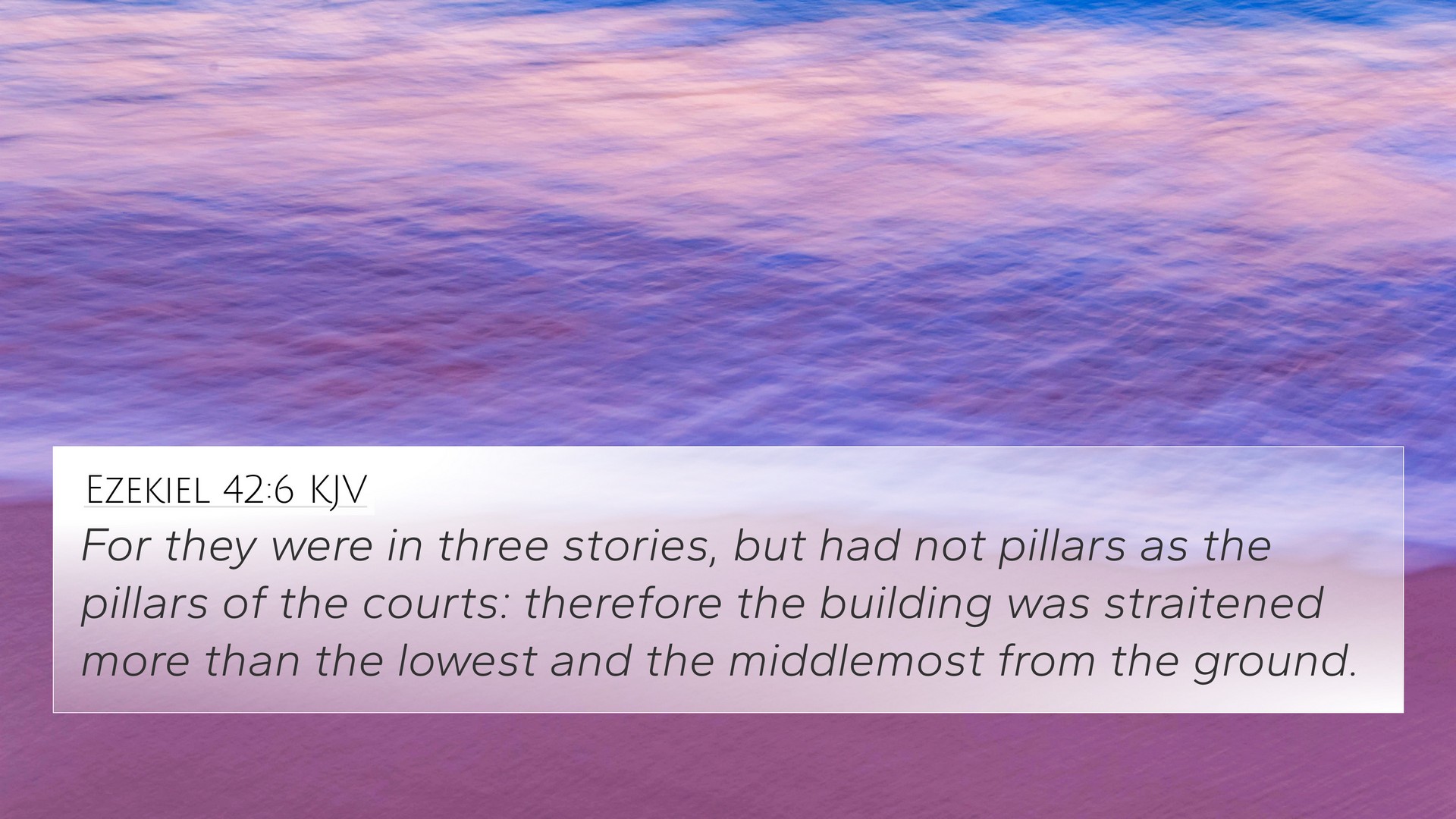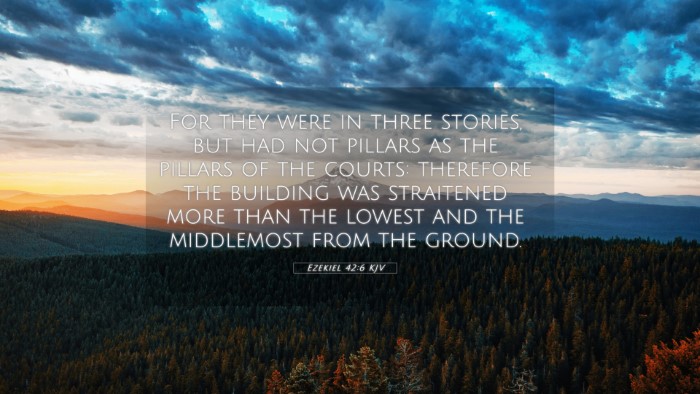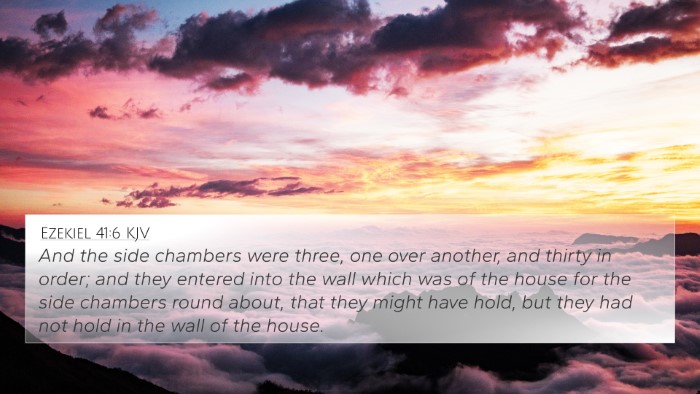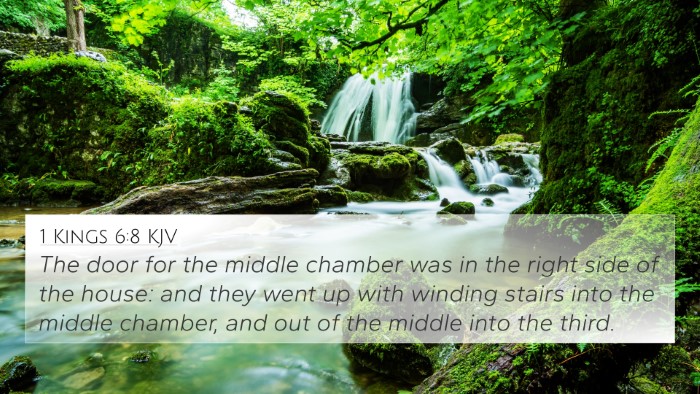Ezekiel 42:6 - Meaning and Interpretation
Bible Verse: Ezekiel 42:6 states, "For they were in three stories, but had not Pillars as the Pillars of the Courts: therefore the upper most was straitened more than the lower and the middlemost." This verse addresses the structure within the temple complex, describing the organization and differences in the levels of the chambers.
Summary of Insights
The verse represents part of Ezekiel's vision of the temple and its chambers, which serves a multifaceted purpose in the context of Israel's worship practices. Various commentaries provide a more nuanced understanding of the verse:
- Matthew Henry:
Henry emphasizes the significance of the temple structure, highlighting the orderly nature of divine worship. The lack of pillars in these upper chambers indicates a uniqueness in divine provision and the data revealing God’s majesty and transcendence.
- Albert Barnes:
Barnes discusses how the divisions of the chambers symbolize different levels of spiritual experiences and responsibilities in worship. He underlines the importance of understanding the architectural design as indicative of Israel’s journey toward completeness in their communion with God.
- Adam Clarke:
Clarke interprets the different levels as representations of the various stages of faith and relationship with God. He notes that the limitation in height reflects the limitations placed on Israel during certain periods of their history.
Thematic Connections with the Scriptures
The verse provides connections to various other scriptural passages, establishing a robust inter-Biblical dialogue:
- Psalms 27:4: A desire for closeness to God, reflecting the longing for divine presence akin to the sacred spaces described in Ezekiel.
- Hebrews 8:5: This verse discusses the earthly tabernacle's reflection of heavenly realities, connecting the notation of structure with spiritual significance.
- 1 Kings 6:2: Details the construction of Solomon's temple, which links to Ezekiel's temple vision through architectural continuity.
- Matthew 21:12-13: Jesus cleanses the temple, establishing a connection on the importance of holiness in worship spaces.
- Revelation 21:22: There is no temple in the New Jerusalem, indicating a progression in the nature of divine habitation amongst people.
- Isaiah 66:1: Marks the understanding that heaven is God’s throne and the earth His footstool, pointing towards the imperfection of earthly temples.
- 2 Chronicles 3:3: Offers insights into the dimensions of Solomon’s temple, reinforcing the significance of the temple design.
Cross-Referencing Biblical Texts
Cross-referencing provides tools crucial for deeper Bible study and understanding:
- Understanding Architecture of Worship: Cross-reference with Exodus 25:40 to see the prescribed design versus Ezekiel's vision.
- Comparative Analysis: Link Ezekiel 42:6 with Nehemiah 3:1-32 where the rebuilding of Jerusalem showcases devotional structures.
- Spiritual Significance: Connecting this with Romans 12:1 underlines the personal offering as a living sacrifice, reflecting the roles of the temple.
- Connecting Old and New Testaments: Linking Ezekiel and Revelation underscores the continuity of God’s relationship with humanity.
Understanding Context and Application
The careful study of Ezekiel 42:6 reveals much about the nature of God's interaction with His people:
- Patterns in Worship: The architecture serves as a metaphor for the varying degrees of faith expressions and their significance in cultural worship.
- Spiritual Growth: The chambers symbolize stages in one's spiritual journey, encouraging believers to strive for intimacy with God.
- Temporal vs. Eternal: It invites reflection on the limitations of earthly structures versus the eternal nature of God’s kingdom.
Practical Tools for Bible Cross-Referencing
Utilize a variety of tools and methods for effective Bible study:
- Employ a Bible Concordance for identifying key themes in scripture.
- Use a Cross-Reference Bible Study Guide for organized themes and verses.
- Explore Comprehensive Bible Cross-Reference Materials to broaden understanding.
Conclusion
In conclusion, Ezekiel 42:6 carries rich layers of meaning and significance that invite further exploration. By understanding the impact of temple architecture on worship and its representation in scripture, believers can deepen their relational dynamics with God through the use of cross-referencing biblical texts.




